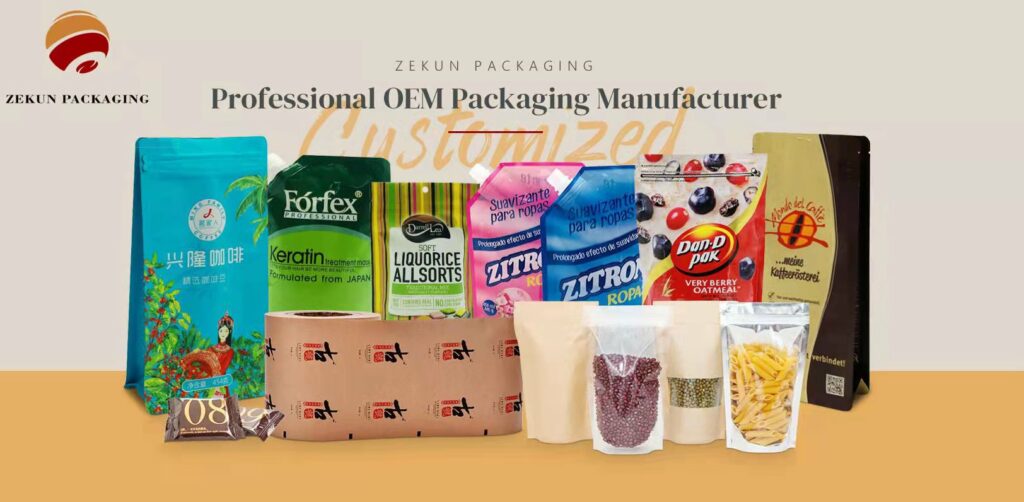
In modern society, the packaging industry has firmly established itself as the second largest consumer industry chair, second only to the clothing industry. In our lives, packaging bags can also be seen everywhere. So, do you know the most commonly used packaging? Do you know what technologies are used? What is the classification of packaging technology? Today, the editor of Zekun will answer you one by one.
In terms of functionality, our packaging technology can be divided into:
1. Moisture-proof packaging
Moisture-proof packaging is to prevent external moisture from affecting the goods, and use materials with water vapor resistance to package the goods;
2. Waterproof packaging
The obvious meaning of waterproof packaging is waterproof, to prevent the deterioration of goods due to water, etc.;
3. Dust-proof packaging
Dust-proof packaging is usually sealed to prevent dust from entering the packaging container and affecting the quality of the product;
4. Anti-mold packaging
Anti-mold packaging can prevent mildew and spoilage of organic products, such as preventing food from becoming moldy;
5. Insect-proof packaging
Insect-proof packaging is a packaging method in which pesticides are added to packaging materials or packaging containers to protect the contents from pests;
6. Anti-vibration packaging
Anti-vibration packaging, also known as cushioning packaging, refers to packaging that takes certain protective measures to reduce the impact and vibration of the content and protect it from damage;
7. Anti-theft packaging
Anti-theft packaging is a packaging designed to prevent the content from being stolen, and it will leave irreparable traces after unsealing;
8. Vacuum packaging
Vacuum packaging is an airtight packaging method in which a vacuum is drawn before sealing and a vacuum is reached after sealing;
9. Inflatable packaging
Inflatable packaging is a packaging in which carbon dioxide and nitrogen are flushed into a sealed packaging container;
10. Breathable packaging
Breathable packaging is a packaging that allows air to enter and exit;
11. Skin packaging
Skin packaging is to place items on a bottom plate made of cardboard or plastic film, which is breathable A packaging method on the bottom plate;
12. Blister packaging
Blister packaging is a packaging method in which items are sealed between a blister formed of transparent plastic sheets and a bottom plate made of composite materials;
13. Aseptic packaging
Aseptic packaging is the aseptic processing of packaging materials and containers in contact with items, and the packaging of items in a sterile environment;
14. Frozen packaging
Frozen packaging is a packaging method that prevents the frozen contents from being lost during the freezing, transportation, and storage processes, and does not dry and taste;
15. Fresh-keeping packaging
Fresh-keeping packaging is a packaging method that enables fresh fruits and vegetables to maintain the original product color, aroma and taste under certain time and conditions;
16.Insulation packaging
Thermal insulation packaging is a packaging that takes certain protective measures to reduce the heat exchange between the packaged items and the external environment during storage and transportation.
17. Shrink packaging
Shrink packaging is a packaging technology method in which items (or inner packaging) are wrapped with shrink film, and then the film is appropriately heated to shrink the film and close to the item (or inner packaging). Shrink film is a polyethylene film that has undergone special stretching and cooling treatments. Because the film generates residual shrinkage stress during directional stretching, this stress will be eliminated after a certain amount of heat, so that it will shrink sharply in both the horizontal and vertical directions. At the same time, the thickness of the film is increased. The shrinkage rate is usually 30 to 70%. The shrinkage force reaches the maximum during the cooling stage and can be maintained for a long time.
18. Stretch packaging
Stretch packaging is a new packaging technology adopted in the 1970s. It is developed from shrink packaging. Stretch packaging relies on mechanical devices to stretch and tightly wrap an elastic film around the packaged item at room temperature. A packaging method that seals at the end. Since stretch packaging does not require heating, the energy consumed is only one twentieth of shrink packaging. Stretch packaging can be used to pack a single item, or it can be used for collective packaging such as pallet packaging.
Summarize the classification of packaging
1. According to the product operation mode: domestic product packaging, export product packaging, special product packaging;
2. According to the role of packaging in the circulation process, there are single-piece packaging, middle packaging and outer packaging, etc.;
3. Classified by packaging product materials: paper product packaging, plastic product packaging, metal packaging, bamboo and wood packaging, glass container packaging and composite packaging, etc.;
4. According to the number of times the packaging is used: one-time packaging, multiple-use packaging and turnover packaging, etc.;
5. According to the degree of softness and hardness of the packaging container: hard packaging, semi-rigid packaging and flexible packaging, etc.;
6. Divided by product types: food packaging, pharmaceutical packaging, mechanical and electrical product design packaging, dangerous goods packaging, etc.;
7. According to function: there are transportation packaging, storage packaging and sales packaging, etc.;
8. According to packaging technology methods: shock-proof packaging, moisture-proof packaging, rust-proof packaging, mildew-proof packaging, etc.
We will share the above 18 packaging technologies here. If you want to know more about packaging knowledge, please pay attention to Hunan Zekun Packaging Technology Co., Ltd.: https://www.zekunpackaging.net/ or https://www.zekunpackaging.com/

No comment yet, add your voice below!